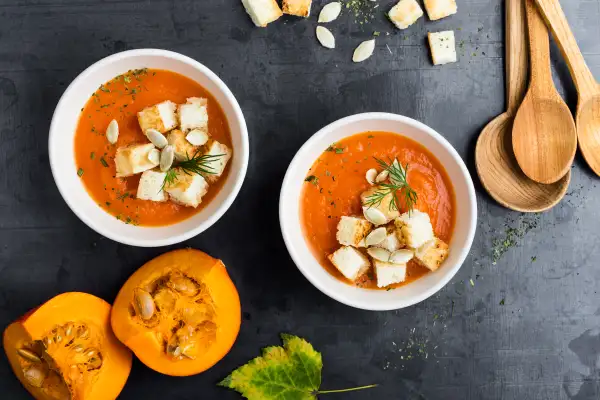You’re Probably Cooking Pumpkin and Butternut Squash All Wrong. Here Are the Kitchen Tools You Need

Butternut squash bisque, baked hubbard squash, stuffed acorn squash, classic pumpkin pie: Now's the time of year to prepare these tasty autumn dishes because the winter squashes they feature have stepped into the starring role at farmers’ markets and in recipe columns. The only problem, beyond picking between competing candidates for the best butternut squash soup recipe, is that it can be difficult to simply get physically into these thick-skinned gourds.
The hardy rinds of pumpkins and other winter squash are tough nuts to crack, so to speak, and the dense texture of the flesh, while awesome in everything from soup to mashed potato variations, can make chopping them up a formidable meal-prep task. We weren't surprised to see that "how to cube butternut squash" has been a hot search term on Google lately.
You could give in and buy canned pumpkin or the pre-peeled and sliced squash. But smart home cooks known that it’s always much, much cheaper to buying them whole. So how do you cook butternut squash and other squashes? It helps to have the right tools, as well as some tips from experienced cooks. Follow the suggestions here and you can save money and put some hearty, satisfying fall dishes on the table.
Get the best knife possible.
When it comes to knives, a well-made knife isn’t cheap, but we’ve got some suggestions that won’t break the bank if you’re ready to take the plunge (see what we did there?) based on the recommendations of equipment testers and food bloggers.
Although it’s not cheap at $145, there’s one knife out there that gets raves from all corners of the Internet: The eight-inch Mac Knife Professional Hollow Edge Chef's Knife. The pros at product review site Wirecutter liked that it’s heavy enough to take on tough squash, and the indentations along the sides keep the knife from sticking to the flesh. If you want to geek out hard on your cutlery, the site Cooking For Engineers has an exhaustive test of chef’s knives and also proclaimed this knife the best. And if that’s still not enough to convince you, this knife has a 4.7 star rating on Amazon.
Most of the top well-known knife brands are either German or Japanese. When it comes to squash, Germany gets the (ahem) edge here; the blades tend to be heavier and made of a softer steel — and believe it or not, harder steel is more brittle and could leave you with chips in your knife. So if you can’t choke down paying more than $100 for a knife, take the recommendation of Food & Wine. Their experts liked the sturdy J.A. Henckels International Classic Chef's Knife, which is a reasonable $55. Another cheaper knife from a top brand name is the $35 Wüsthof Pro Cook’s Knife, which Wirecutter liked as a budget pick.
Large knives and cleavers for pumpkins and squash.
As some home cooks on Chowhound have noted, even an eight-inch chef’s knife might not be long enough to get all the way through truly giant gourds. Try a 12-inch knife if you plan to be tackling the Great Pumpkin or any of its cousins this autumn. This 12-inch upgrade on the Wüsthof model above is just $15 more.
Or, you can go with the method lots of Chowhound users swear by: Toss the whole squash in the microwave for 30 seconds to a few minutes (depending on the size of your squash and the power output of your microwave) to soften the skin before taking a blade to it. Or, more correctly, blades: After softening the outside in the microwave, use a serrated knife to make an initial, relatively shallow cut.
Then, break out the heavy equipment: a cleaver and a mallet. You can get a Chinese-style cleaver for relatively little money — this one is only around $10 and has glowing reviews on Amazon.
After that, head to the garage (that is, unless you keep a mallet laying around in your kitchen) and grab a rubber mallet to lightly coax the cleaver the rest of the way through the squash until it cracks open or you can pull it apart with your hands.
Best vegetable peelers for squash.
According to Epicurious, chef’s knives aren’t the best pick for removing the rind of hard winter squashes; the blades are just too big and unwieldy to do the job correctly. If you’re dealing with a hard squash with a relatively soft skin like a butternut, you can peel it with a sturdy vegetable peeler like this one that gets an impressive 4.8 star ranking on Amazon.
If the skin is more stubborn, you can cut the squash into large pieces and remove the skin with a paring knife. Happily, you can pick up a paring knife for very little: This Amazon best-seller (it has more than 2,000 reviews!) from a top brand is just $7.
To scoop out the seeds, you can use a regular spoon or an ice cream scoop to do the job effectively. And to keep your knife sharp, use a cutting board; one tip that turns up frequently is to make sure you’re using a cutting board that has rubber grips or feet so it won’t slide all over the counter.
We’ve included affiliate links into this article. Click here to learn what those are.
